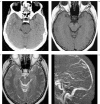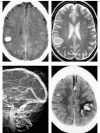Clinical Presentation, Imaging and Treatment of Cerebral Venous Thrombosis (CVT)
- PMID: 20594505
- PMCID: PMC3572523
- DOI: 10.1177/159101990200800102
Clinical Presentation, Imaging and Treatment of Cerebral Venous Thrombosis (CVT)
Figures




Similar articles
-
Cerebral venous thrombosis: state of the art diagnosis and management.Neuroradiology. 2018 Jul;60(7):669-685. doi: 10.1007/s00234-018-2032-2. Epub 2018 May 11. Neuroradiology. 2018. PMID: 29752489 Review.
-
Cerebral venous thrombosis in Argentina: clinical presentation, predisposing factors, outcomes and literature review.J Stroke Cerebrovasc Dis. 2020 Oct;29(10):105145. doi: 10.1016/j.jstrokecerebrovasdis.2020.105145. Epub 2020 Jul 28. J Stroke Cerebrovasc Dis. 2020. PMID: 32912503 Review.
-
Pediatric Cortical Vein Thrombosis: Frequency and Association With Venous Infarction.Stroke. 2016 Mar;47(3):866-8. doi: 10.1161/STROKEAHA.115.011291. Stroke. 2016. PMID: 26888536 Free PMC article.
-
Cerebral Venous Thrombosis Headache.Curr Pain Headache Rep. 2019 May 30;23(7):47. doi: 10.1007/s11916-019-0786-9. Curr Pain Headache Rep. 2019. PMID: 31147848 Review.
-
Cerebral venous thrombosis--clinical presentations.J Pak Med Assoc. 2006 Nov;56(11):513-6. J Pak Med Assoc. 2006. PMID: 17183979 Review.
Cited by
-
Successful intravascular ultrasound thrombolysis of dural sinus thrombosis with pre-existing subarachnoid and intraparenchymal hemorrhages.Interv Neuroradiol. 2010 Dec;16(4):455-8. doi: 10.1177/159101991001600414. Epub 2010 Dec 17. Interv Neuroradiol. 2010. PMID: 21162778 Free PMC article.
-
Cerebral sinovenous thrombosis. Neuroimaging diagnosis and clinical management.Interv Neuroradiol. 2008 Nov 11;14 Suppl 2(Suppl 2):35-40. doi: 10.1177/15910199080140S208. Epub 2009 Jan 2. Interv Neuroradiol. 2008. PMID: 20557799 Free PMC article.
-
Intracerebral Hemorrhage due to Thrombosis with Thrombocytopenia Syndrome after Vaccination against COVID-19: the First Fatal Case in Korea.J Korean Med Sci. 2021 Aug 9;36(31):e223. doi: 10.3346/jkms.2021.36.e223. J Korean Med Sci. 2021. PMID: 34402235 Free PMC article.
-
Treatment of progressive cerebral sinuses thrombosis with local thrombolysis.Interv Neuroradiol. 2012 Mar;18(1):89-96. doi: 10.1177/159101991201800112. Epub 2012 Mar 16. Interv Neuroradiol. 2012. PMID: 22440606 Free PMC article. Clinical Trial.
-
Bilateral corpus callosum and corona radiata infarction due to cerebral venous sinus thrombosis presenting as headache and acute reversible aphasia: a rare case report.BMC Neurol. 2020 Jun 19;20(1):249. doi: 10.1186/s12883-020-01829-7. BMC Neurol. 2020. PMID: 32560642 Free PMC article.
References
-
- Rosendaal FR. Thrombosis in the young: epidemiology and risk factors. A focus on venous thrombosis. Thromb Haemost. 1997;78:1–6. - PubMed
-
- Manco-Johnson MJ, Nuss R, et al. Combined thrombolytic and anticoagulant therapy for venous thrombosis in children. J Pediatr. 2000;136:446–453. - PubMed
-
- Ameri A, Bousser MG. Cerebral venous thrombosis. Neurol Clin. 1992;10:87–111. - PubMed
-
- de Bruijn SF, Stam J. Randomized, placebo-controlled trial of anticoagulant treatment with low-molecular-weight heparin for cerebral sinus thrombosis. Stroke. 1999;30:484–488. - PubMed
LinkOut - more resources
Full Text Sources

